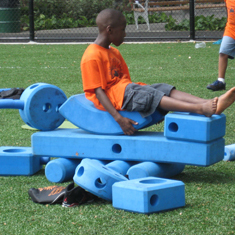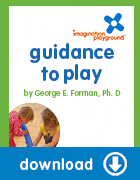Of all the Loose Parts, the cylinder-shaped Plug has a strong identity appeal.
It looks like a little person but because it is a stretched length of round, it also affords many types of dynamic functions such as seesaws, balance games, and axles. It has the power to connect two parts with holes in which it fits.

The Plug has the shape and feel of a torso, something life-like. We see this child has “adopted” this cylinder as her baby. She has wrapped it in a blanket like a good mother.

Ancient fishing boats moved over the beach at low tide using logs as roller wheels. This young man invented a car that uses that same principle. The last Plugbecomes the first as he moves his car forward.
What It Means
Laying down many Plugs on a flat surface creates a rolling floor, like the early whalers used to get the boats off the beach. In many ways, this cylinder plays a core role in the entire set. It also has the intriguing attribute of being both stable and mobile. Resting on its flat end it is stable. Resting on its round side it is mobile. Children will ponder the orientation of the cylinder much more than they will for the other blocks, given the opposite effects when one changes its orientation.
2-4 Year Olds
In the first stage children will likely treat the Plug as a pretend baby or person. With boys this may occur as a “knock him down” game, with girls as a “take care of him” game. Young children will want to carry, stand, cuddle, and lay on large cylinders. They might even form an emotional attachment to these particular parts.
4-7 Year Olds
For older children, the Plugs will be put into the holes of other blocks, perhaps not to join blocks, but to create a protrusion for the rectangular blocks. The idea of using these cylinders as a pinion to join two or more blocks will require a bit more thought.
7-10 Year Olds
For still older children the full range of functional uses will be seen in teeter-totters, car axles, or pinions to join multiple blocks. As children grow into group games with rules, they will stand the cylinders as goal posts, boundary markers, or slalom gates in their athletic games.
This material is adapted from the publication “Imagination Playground’s Guidance to Play” by George E. Forman, PhD, Emeritus Professor, University of Massachusetts (Amherst) and President of Videatives, Inc.
Dr. Forman has over 33 years of experience in university teaching, cognitive research, multimedia design and educational consulting in the area of early childhood learning and development.
“Guidance to Play” covers 20 topics that help illustrate the significance in what children are doing as they play as well as concrete actions Play Associates can take to facilitate positive behaviors.



